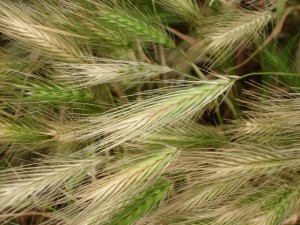It’s that time of year again, and I’m seeing bristly foxtail grasses everywhere. In early spring these soft, green grasses sway gently with the breeze, however don’t let that soft appearance fool you. Once foxtails become dry, their awns become razor sharp needles that are extremely dangerous to dogs. The awns, which are barbed like a fish hook, are designed to penetrate into the ground with the seed, however they can also burrow through a dog’s skin, and eyes, entering soft tissue where they can cause serious injury, infection and death!
To help keep your pup safe, I’m sharing this important information from WebMD, and reminding pet parents to be vigilant about watching for foxtails whenever you’re out with your dog. If your dog shows any of the symptoms associate with the health problems foxtails can cause, consult with your veterinarian immediately!
Foxtail Grass and Your Dog
Reprinted from WebMD
Foxtail plants can be risky for your dog. The barbed seed heads of the foxtail plant can work their way into any part of your dog or cat, from the nose to between the toes and inside the ears, eyes, and mouth. They can even simply dig themselves directly into a patch of skin.
The foxtail plant is a grass-like weed. It is mostly found in the Western half of the U.S.
The danger of foxtails goes beyond simple irritation. Because these tough seeds don’t break down inside the body, an embedded foxtail can lead to serious infection for your dog. It can even lead to death if left untreated. The seeds can be hard to find in your dog’s fur.
So how can you tell if your pooch has a foxtail that’s causing problems? If you find a foxtail should you extract it? And when is it time to call a vet?
Foxtails and Your Dog: Risks and Symptoms
Foxtails travel. Moving relentlessly forward, never back, they can migrate from inside your dog’s nose to its brain. They can dig through skin or be inhaled into — and then perforate — a lung.
Embedded foxtails can cause discharge, abscesses, swelling, pain, and death. If your dog is displaying any of the following symptoms, check for foxtails or talk to your vet:
Feet. Foxtails love your dog’s feet and can easily become embedded between tender toes. Check for foxtails if you notice swelling or limping or if your dog is constantly licking the area.
Ears. If your pooch is shaking his head, tilting it to the side, or scratching incessantly at an ear, this could be the sign of a foxtail — one that may be so deep inside the ear canal you can’t see it. Your veterinarian needs to take a look using a special scope.
Eyes. Redness, discharge, swelling, squinting, and pawing all may be signs your dog has a foxtail lodged in its eye. If you think this may be the case, seek veterinary care immediately.
Nose. If you see discharge from the nose, or if your dog is sneezing frequently and intensely, there may be a foxtail lodged in a nasal passage.
Vagina or penis. Foxtails can find their way into these areas, too. So if you notice your dog persistently licking at its genitals, foxtails could be the cause.
Tips for Preventing Foxtail Problems
Any dog can get foxtails in the ears, nose, eyes, or mouth. But dogs with long ears and curly hair can be especially prone to foxtail problems. Prevent issues by:
Examining your pet’s coat during foxtail season — generally May through December — especially if you’ve gone walking in open fields. Brush your dog as necessary, looking especially closely for pointy foxtail awns in your dog’s thick or feathery fur.
Check your pup’s face and ears carefully for foxtails. Don’t forget to look in and around your pooch’s mouth and gums.
Carefully check your dog’s paw pads for foxtails — especially between the toes.
Use tweezers to remove any foxtails you can easily get to. But if a foxtail is deeply embedded, or if the area around it is red or swollen, call your veterinarian right away. Remember, foxtails won’t come out on their own, and they can burrow into the brain, spine, eardrums, lungs — actually, anywhere.
The easiest way to prevent foxtail problems is to keep your dog out of overgrown, grassy areas. You should also pull out any foxtail plants you find in your yard. Also consider trimming your dog’s hair during foxtail season, especially if it tends to persistently get foxtails in one spot.



